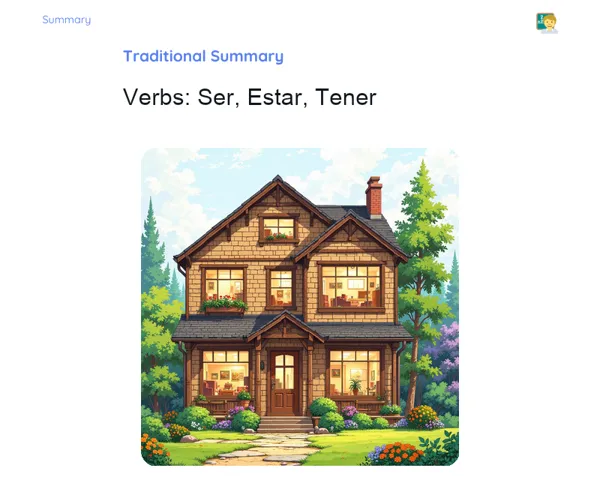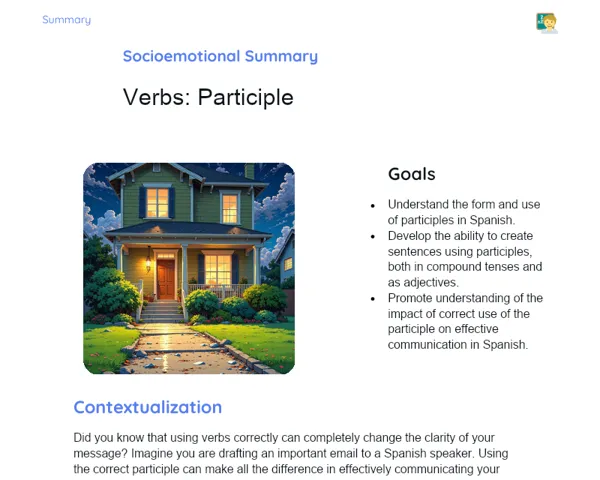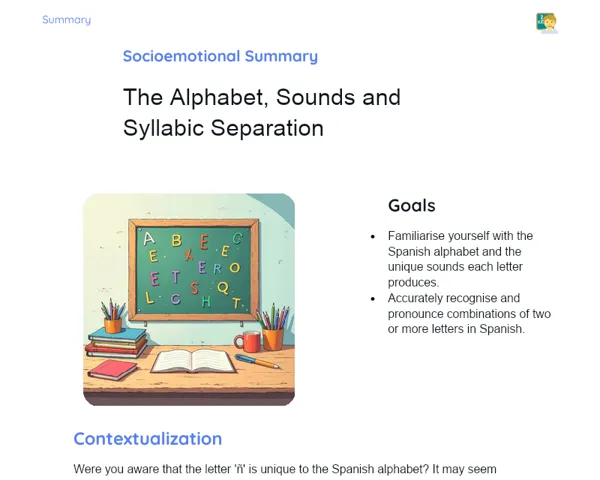Goals
1. Understand and apply the conjugation of regular verbs in the present indicative tense in Spanish.
2. Understand and apply the conjugation of irregular verbs in the present indicative tense in Spanish.
3. Develop the skill to identify patterns in regular and irregular verbs.
4. Promote practical application of verbs in everyday phrases and contexts.
Contextualization
Verbs form the backbone of any language. Mastering their conjugation in the present indicative tense in Spanish not only enhances everyday communication but also paves the way for professional opportunities in companies that value language fluency. Picture yourself in a meeting with colleagues from a branch in Spain or in a video conference with Spanish-speaking clients: knowing how to conjugate verbs accurately can be a game-changer. For instance, engaging effectively in a business meeting hinges on the ability to use verbs correctly in the present indicative, ensuring clear and effective communication.
Subject Relevance
To Remember!
Conjugation of Regular Verbs in the Present Indicative
Regular verbs in the present indicative in Spanish follow specific patterns. For verbs ending in -ar, -er, and -ir, the endings differ based on the subject. Grasping these patterns not only helps in communication but also ensures that your message is conveyed accurately.
-
Verbs ending in -ar: e.g., hablar (I speak, you speak, he/she speaks, we speak, you all speak, they speak)
-
Verbs ending in -er: e.g., comer (I eat, you eat, he/she eats, we eat, you all eat, they eat)
-
Verbs ending in -ir: e.g., vivir (I live, you live, he/she lives, we live, you all live, they live)
Conjugation of Irregular Verbs in the Present Indicative
Irregular verbs do not adhere to a fixed conjugation pattern in the present indicative, necessitating memorization and practice. These commonly used verbs are crucial for effective communication.
-
Verbs with root changes: e.g., tener (I have, you have, he/she has, we have, you all have, they have)
-
Verbs with spelling changes: e.g., conocer (I know, you know, he/she knows, we know, you all know, they know)
-
Other common irregular verbs: ser (I am, you are, he/she is, we are, you all are, they are)
Differences and Similarities between Regular and Irregular Verbs
While all verbs in the present indicative serve the function of indicating actions or states in the present, their conjugation forms can differ significantly. Recognizing these differences and similarities is key to avoiding common errors and enhancing fluency.
-
Similarity: All verbs indicate actions or states in the present.
-
Difference: Regular verbs follow established conjugation patterns, while irregular verbs don’t.
-
Impact on communication: Mistakes in conjugating irregular verbs can cause misunderstandings, highlighting the importance of consistent practice and memorization.
Practical Applications
-
In a business meeting with Spanish-speaking colleagues, accurately using verbs in the present indicative ensures clear and professional communication.
-
In customer service, correct verb conjugation in Spanish can significantly enhance service quality and customer satisfaction.
-
During a job interview in a multinational firm, showcasing proficiency in conjugating verbs in the present indicative can provide a competitive edge.
Key Terms
-
Regular Verbs: Verbs that follow a fixed pattern of conjugation.
-
Irregular Verbs: Verbs that do not follow a fixed pattern of conjugation and require memorization.
-
Present Indicative: A verb tense that indicates actions or states occurring in the present moment.
Questions for Reflections
-
How does your ability to conjugate verbs correctly impact your communication in professional settings?
-
What challenges have you faced while learning the conjugation of irregular verbs, and how do you plan to tackle them?
-
In what ways can proficiency in Spanish unlock new professional opportunities for you in the future?
Practical Challenge: Conjugating in Real Contexts
This mini-challenge aims to solidify your understanding of verb conjugation in the present indicative by implementing them in everyday and professional scenarios.
Instructions
-
Select one of the hypothetical professional scenarios below:
-
Business meeting with Spanish-speaking colleagues.
-
Customer service in a multinational firm.
-
Job interview at an organization that values fluency in Spanish.
-
Craft a dialogue of 5-10 lines for each character, incorporating verbs in the present indicative.
-
Utilize both regular and irregular verbs in your lines.
-
Present your dialogue to a colleague or group, simulating the chosen context.
-
Reflect on any mistakes made and the successes, aiming to improve with each practice.



